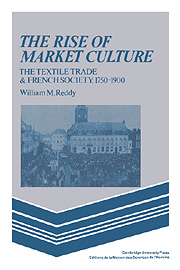Book contents
- Frontmatter
- Contents
- List of figures and maps
- List of abbreviations
- Preface
- Introduction
- Part One A world without entrepreneurs, 1750–1815
- Part Two Uses of the market idea, 1816–1851
- Part Three Unquestioned assumptions, 1852–1904
- 8 The clock time of the Second Empire
- 9 The moral sense of farce
- 10 Little insurrections
- Conclusion
- Notes
- Bibliographical note
- Index
10 - Little insurrections
from Part Three - Unquestioned assumptions, 1852–1904
Published online by Cambridge University Press: 30 September 2009
- Frontmatter
- Contents
- List of figures and maps
- List of abbreviations
- Preface
- Introduction
- Part One A world without entrepreneurs, 1750–1815
- Part Two Uses of the market idea, 1816–1851
- Part Three Unquestioned assumptions, 1852–1904
- 8 The clock time of the Second Empire
- 9 The moral sense of farce
- 10 Little insurrections
- Conclusion
- Notes
- Bibliographical note
- Index
Summary
Under the Second Empire a new consensus was achieved among laborers and mill owners to the effect that equal effort and equal time ought to receive equal pay. This consensus provided a guide for the introduction of new spinning and weaving technology during the long mid-century boom. It amounted to a proper conceptualization of labor as a commodity in that the justice of a pay rate was now firmly linked to abstract features of the laborer's behavior instead of to tangible amounts of product - although the product continued to be the immediate thing that was paid for. Strikes were legalized, defined in law as the withholding of a commodity from sale; and textile laborers had by 1871 made several experiments with this new form of action.
Under the Third Republic there were further reforms in the same direction. Unions were legalized in 1884; an optional state arbitration and conciliation procedure was set up in the early 1890s. The state threw its weight firmly behind the idea that labor conflict represented a normal facet of bargaining between freely contracting parties.
But these changes in the end did little to alter the social position of textile laborers. Even if there was a consensus available now for bargaining about pay rates under certain circumstances, there was still no firm consensus about the form that bargaining ought to take. And very little in the way of formal bargaining occurred; owners simply refused to engage in it. Competitive pressures remained restrained and indirect in their impact on the distribution of labor.
- Type
- Chapter
- Information
- The Rise of Market CultureThe Textile Trade and French Society, 1750–1900, pp. 289 - 325Publisher: Cambridge University PressPrint publication year: 1984



